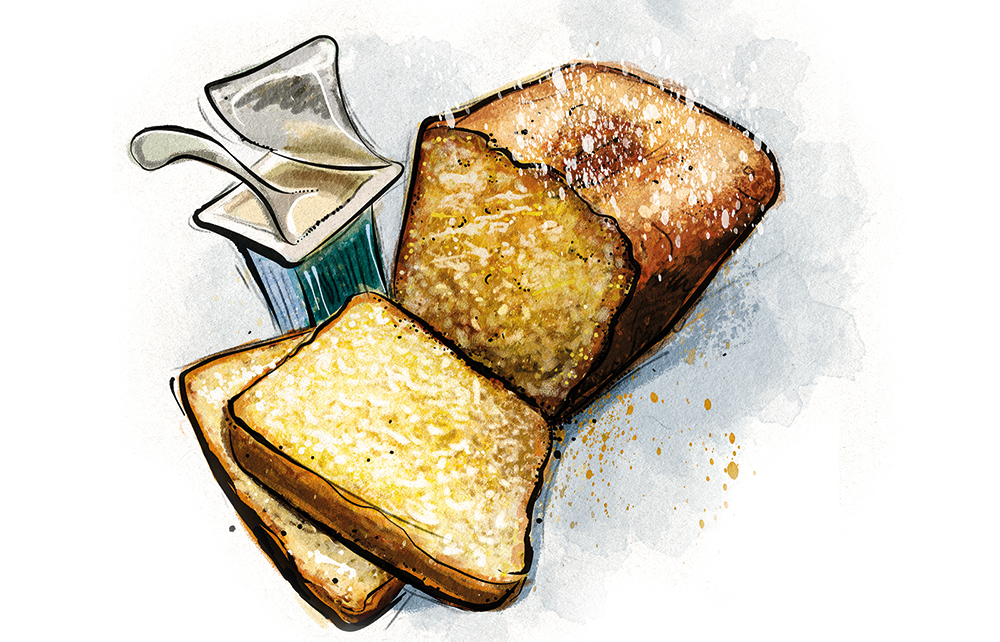I’m pretty easygoing when it comes to most aspects of cooking. I don’t think there’s much to be gained from being dogmatic or dictatorial. It’s just supper, at the end of the day. There are, as they say, many ways to skin a rabbit. And cooking is supposed to be about joy; it’s not an exam.
But the exception is measuring ingredients for baking. Oh boy, do I get on my high horse about this. I can be very boring indeed about the need to measure accurately. The American system of cups and tablespoons drives me mad. Cups are inexact and inaccurate, they rely on scooping and sweeping, they don’t account for the varying density of dry ingredients. Scales, I will declaim – with only the slightest impetus – are inexpensive and an essential piece of kitchen equipment. You simply cannot bake properly without them! You need weight not volume, for goodness’ sake! Baking might not be rocket science, but it is science.
The simplicity of the cake means that it is something of a blank canvas, endlessly customisable
My mind, however, has been changed by a single yoghurt pot. Well, a yoghurt pot and its associated cake. A yoghurt pot cake is a simple cake, in appearance, flavour and conception. It relies on measuring each ingredient by the number of yoghurt pots needed: 1 pot of yoghurt, 2 pots of sugar, 3 of flour etc. This means that the exact size of the yoghurt pot doesn’t matter because, once it is emptied and washed out, the ratio of the other ingredients remains the same. It’s a pleasingly efficient system and one that, despite the aforementioned variabilities of measuring, always seems to work perfectly. How do I reconcile this with my vehement rejection of volume measuring in baking? I don’t. I contain multitudes.
Seriously, though, this is an incredibly forgiving cake, and a lovely one too. The use of yoghurt and oil keeps the crumb fantastically tender, and the sugar makes the crust crisp. This kind of cake is probably best known as the Italian ciambella, or as the French ‘Gâteaux de Mamie’ – granny’s cake – a nod to the fact it is often baked together by grandmothers and grandchildren, because it is so easy to make. But it’s one of those cakes that pops up all over the place, is continually reinvented and rediscovered, thanks to its ease and ingenuity. It’s often called the ‘seven pot cake’ or – my favourite – the more lyrical and somehow mysterious, ‘cake of the seven pots’.
Traditionally, the flavouring is just the zest of a lemon and a little vanilla, or a handful of chocolate chips. But the simplicity of the cake means that it is something of a blank canvas, endlessly customisable – scattering a clutch of fruit through the batter is very popular, or using light brown sugar in place of caster for a caramelly note. I love to replace the zested lemon with an orange and add a splash of orange blossom water. But I think, actually, the two classic versions are the best: the combination of the gentle perfume of lemon zest and the sweet hum of vanilla is subtle but elegant. And the chocolate chips – especially if you ignore my instructions to let the cake cool completely and catch them still warm and a little melty – turn the cake into something perfect for children. The Italians often serve this cake for breakfast (which I love – cake for breakfast always feels a little transgressive), while the French serve it as le goûter, an afternoon snack.
I always have an enormous tub of yoghurt in my fridge, which means that, while I’m never far away from a yoghurt cake, the pot measuring scheme doesn’t always work for me (unless I want to make a cake as big as my kitchen table). So, although it may seem against the spirit of the whole thing, I’m giving weight measurements alongside pot quantities. This cake works in a ring mould, which is how the Italians tend to make it, but it can also be baked in a large loaf tin, or a nine-inch round tin. Just adjust the baking times accordingly.
Serves 8
Takes 10 mins
Bakes 45-60 mins
- 150g/1 individual pot natural yoghurt
- 200g/2 pots caster sugar
- 3 large eggs
- 250g/3 pots plain flour
- 100g vegetable oil
- 1 tsp baking powder
- 1 tsp vanilla paste
- ½ tsp salt
- 1 lemon, zested, or 100g/1 pot chocolate chips
- Icing sugar, for dusting
- Line the base and sides of a 9in round cake tin or a 2lb loaf tin, or grease and flour a 9in ring tin. Preheat the oven to 170°C.
- If you’re using a pot of yoghurt, empty the yoghurt into a bowl, and wash out and dry the pot.
- Whisk together the sugar, eggs and lemon zest (if using), until pale, thick and increased in volume.
- Place the oil, flour, baking powder, vanilla paste, and salt in a bowl with the yoghurt, and stir together until incorporated. Fold through the egg and sugar mixture, followed by the chocolate chips (if using).
- Spoon into your prepared tin and bake for 35-40 minutes for a round tin or a ring tin, or an hour for a loaf tin. The cake should be golden and risen, and should spring back when pressed gently with a finger. Allow to cool for 10 minutes before removing it from the tin and leaving to cool completely, before dusting with icing sugar if you wish.
To sign up for Olivia Potts’s bimonthly newsletter, which brings together the best of The Spectator’s food and drink writing, click here.






Comments